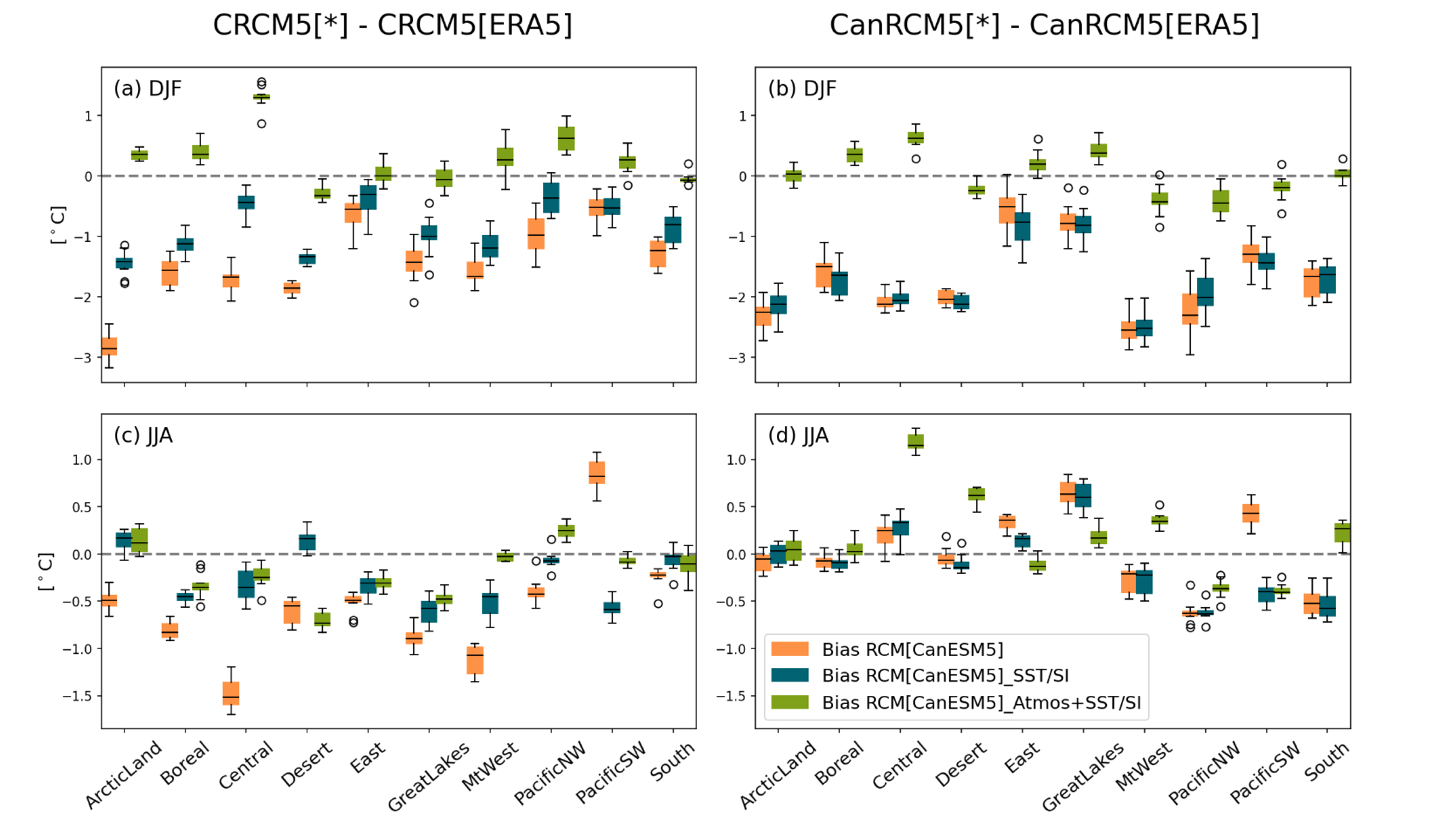Empirical bias correction of global and regional climate models for the meteorological forcing of hydrological models
The aim of this project is to minimize the biases of general circulation models before they are used to drive modelling, thus considerably improving the quality of regional climate model results.
Project details
Principal(s) investigator(s)


Context
Ouranos has long-standing, peer-recognized expertise in regional climate simulation and analysis, which was essential in this ground-breaking scientific research. The Canadian Centre for Climate Modelling and Analysis (CCCma) wished to evaluate the improvement brought about by the empirical bias correction (EBC) method in simulations scaled by two regional climate models (RCMs), including the Canadian Regional Climate Model (CRCM5). In this project, complex meteorological, climate and statistical analyses requiring in-depth knowledge of the physics of the RCMs and the production of regional simulations were carried out to fully understand the processes involved.
This project compares the impact of global CanESM data, enhanced by the EBC method, on two RCMs, and assesses the added value of simulated meteorological variables used as inputs into hydrological models for climate change impact studies. Two RCMs were considered: the CanRCM5, developed by the CCCma, and the CRCM5.
Objective(s)
The aim of this project was to evaluate the applicability of an innovative approach for correcting driving model bias in regional climate simulations, which was recently developed by the CCCma and tested on two ensembles of simulations produced by the CRCM5 and the CanRCM5.
The study involved close collaboration between the CCCma researchers who developed the base method and researchers from Ouranos.
Methodology
-
Analysis and documentation of the added value when scaling RCM simulations with the new EBC method during the historical period (recent past)
-
Analysis and documentation of simulations scaled with the new EBC method in projections by the CanRCM5 and CRCM5 RCMs
-
Analysis and evaluation of the additional benefit of applying the EBC method to the RCMs
The study focused on improvements to the EBC method in the RCM meteorological fields used as inputs into hydrological models (e.g. surface temperature, precipitation, humidity, wind speed). Continental and regional analyses of certain meteorological phenomena were produced.
Results
Continental and regional analyses of CRCM5 and CanRCM5 simulations, with and without bias correction of the CanESM5 driving model for sea temperature and sea ice concentration (SST / SIC), led to two general conclusions:
-
The SST/SIC correction alone is useful, as it has an effect on a regional scale and is simple to implement.
-
Atmospheric correction is beneficial, but more complex to implement.
Specifically, we note significant improvements in the climatology of temperature at 2 m, which is particularly evident in winter in northern regions. Similarly, the climatology of winter precipitation improved, although regions with complex topography and coastal mountain ranges still have considerable biases in the CRCM5. Correcting atmospheric circulation and humidity biases in the CanESM5 before downscaling significantly improves the simulation of nor'easters (cold-season extratropical cyclones) in RCMs. This refinement of their trajectories helps to reduce overestimates of winter precipitation along the east coast for the CRCM5. In addition, the study revealed an improvement in the representation of atmospheric rivers (AR), which modestly reduces the tail of the distribution for precipitation on the West Coast during AR events, particularly in the Vancouver area.
Lastly, the representation of the North American monsoon over northern Mexico benefits from more substantial improvements when only sea surface temperature (SST) and sea ice concentration (SIC) are corrected in RCMs, compared to adding the atmosphere correction to the SST/SIC corrections.

Figure 1: Fig. 1: Box plots of overall temperature bias at 2 m (a-d) and precipitation bias (e-h) in the Bukovsky climatology regions. The results are presented for the CRCM5 (left column) and CanRCM5 (right column), driven by different CanESM5 configurations: uncorrected (orange), corrected SST/SI only (blue), and corrected atmosphere and SST/SI (green). Labonté, Matte, Paquin et al., in prep.
Benefits for adaptation
This project produced an analysis of the benefits of reducing bias in driving data in regional simulations, thereby increasing confidence in the data produced, which can be used in various adaptation studies.
Funding

Other participants
-
Dominique Paquin, Ouranos
-
Marie-Pier Labonté, Ouranos
-
Slava Kharin, Canadian Centre for Climate Modelling and Analysis
Related projects
710300